Report on Financial Management: Analysis and Recommendations
VerifiedAdded on 2023/06/18
|12
|2802
|286
Report
AI Summary
This report delves into the concept and importance of financial management within an organization, emphasizing its role in maximizing wealth. It explores financial statements, including positional and income statements, and demonstrates the application of ratios in financial analysis. A detailed income statement and balance sheet are presented based on provided data, followed by an analysis of profitability, liquidity, and efficiency using ratio analysis. The report identifies key areas for improvement in financial performance and offers actionable suggestions, such as cost-saving techniques, strategic asset acquisition, and optimized capital structure management, aiming to enhance profitability, maximize shareholder wealth, and improve overall productivity. Desklib provides access to more solved assignments and study tools for students.

IMPORTANCE
OF
FINANCIAL
MANAGEMENT
OF
FINANCIAL
MANAGEMENT
Paraphrase This Document
Need a fresh take? Get an instant paraphrase of this document with our AI Paraphraser
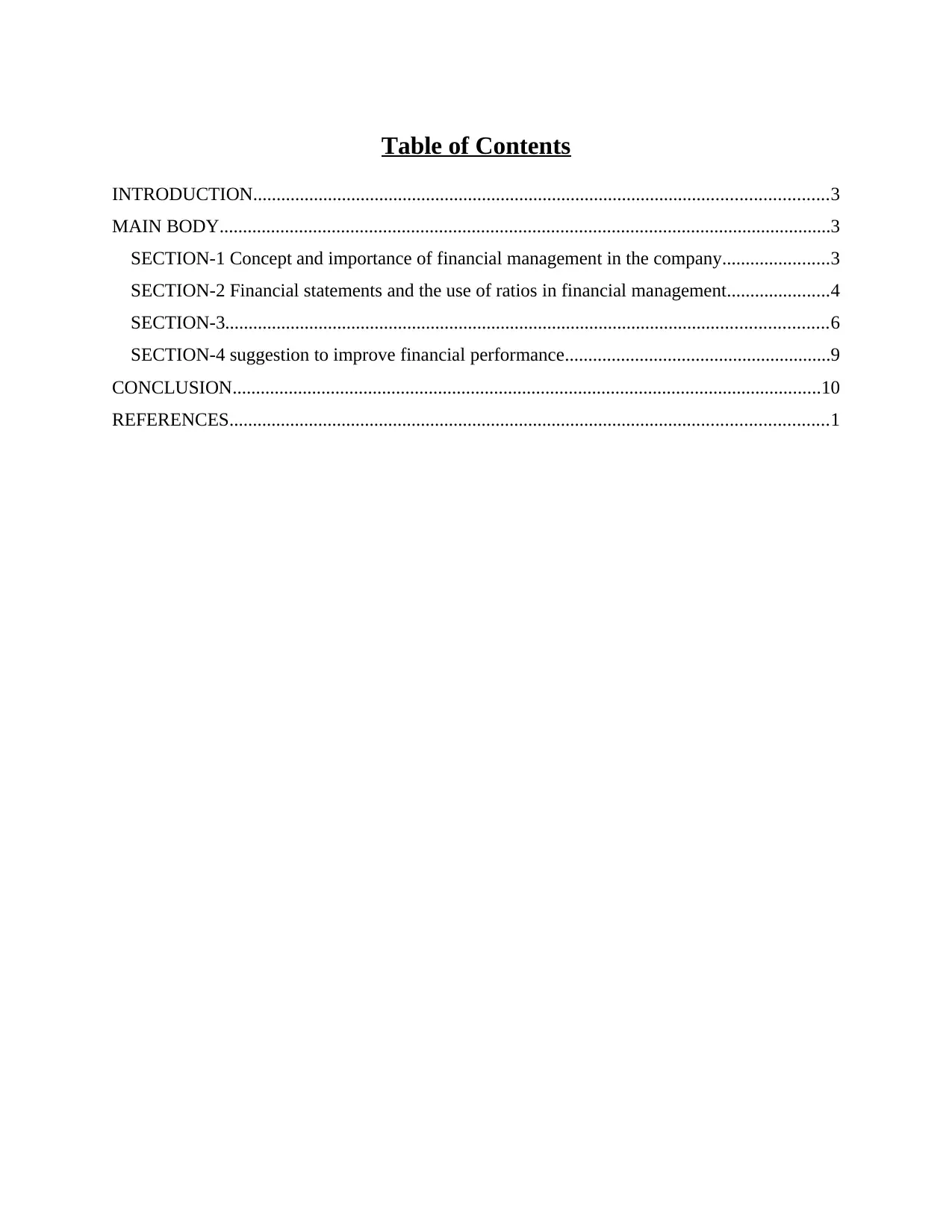
Table of Contents
INTRODUCTION...........................................................................................................................3
MAIN BODY...................................................................................................................................3
SECTION-1 Concept and importance of financial management in the company.......................3
SECTION-2 Financial statements and the use of ratios in financial management......................4
SECTION-3.................................................................................................................................6
SECTION-4 suggestion to improve financial performance.........................................................9
CONCLUSION..............................................................................................................................10
REFERENCES................................................................................................................................1
INTRODUCTION...........................................................................................................................3
MAIN BODY...................................................................................................................................3
SECTION-1 Concept and importance of financial management in the company.......................3
SECTION-2 Financial statements and the use of ratios in financial management......................4
SECTION-3.................................................................................................................................6
SECTION-4 suggestion to improve financial performance.........................................................9
CONCLUSION..............................................................................................................................10
REFERENCES................................................................................................................................1
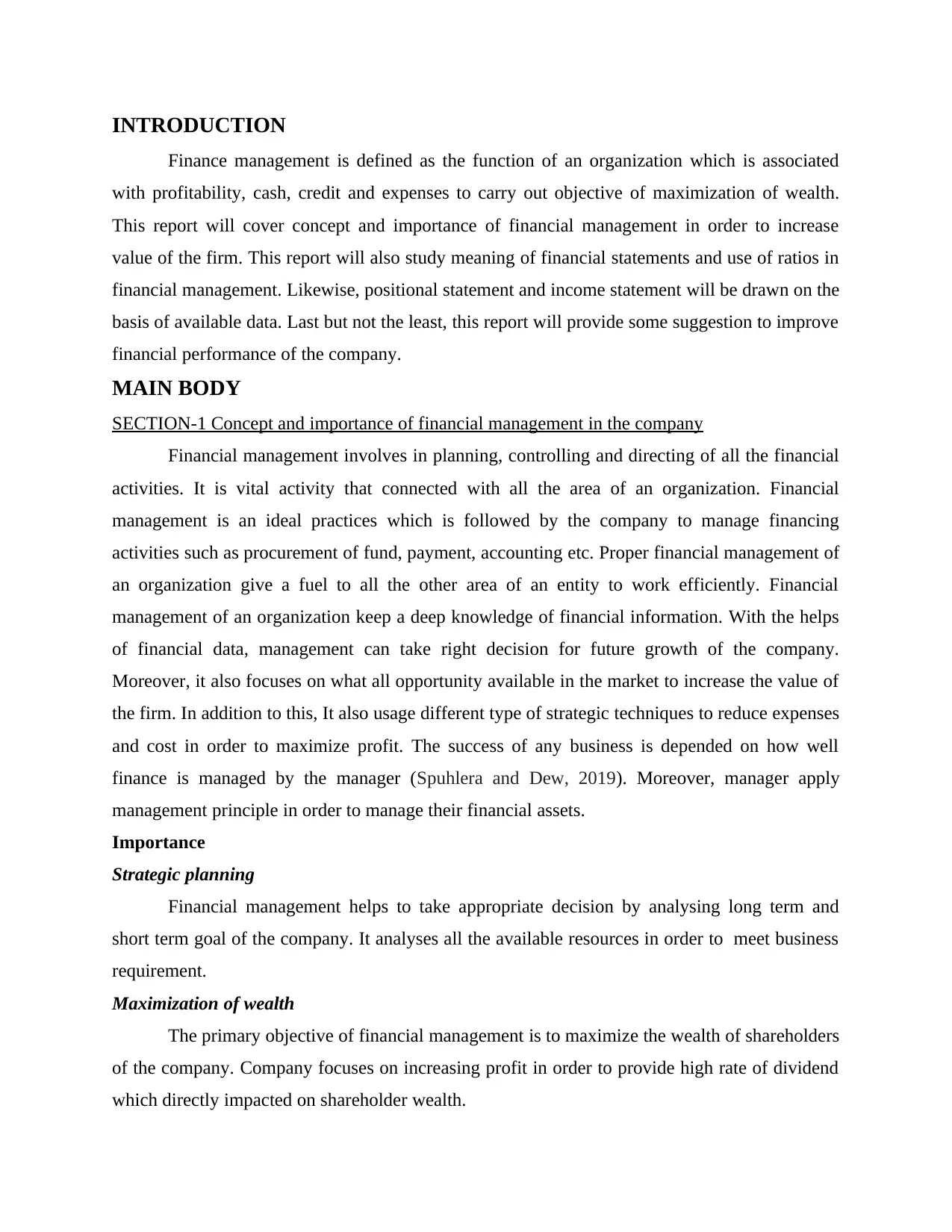
INTRODUCTION
Finance management is defined as the function of an organization which is associated
with profitability, cash, credit and expenses to carry out objective of maximization of wealth.
This report will cover concept and importance of financial management in order to increase
value of the firm. This report will also study meaning of financial statements and use of ratios in
financial management. Likewise, positional statement and income statement will be drawn on the
basis of available data. Last but not the least, this report will provide some suggestion to improve
financial performance of the company.
MAIN BODY
SECTION-1 Concept and importance of financial management in the company
Financial management involves in planning, controlling and directing of all the financial
activities. It is vital activity that connected with all the area of an organization. Financial
management is an ideal practices which is followed by the company to manage financing
activities such as procurement of fund, payment, accounting etc. Proper financial management of
an organization give a fuel to all the other area of an entity to work efficiently. Financial
management of an organization keep a deep knowledge of financial information. With the helps
of financial data, management can take right decision for future growth of the company.
Moreover, it also focuses on what all opportunity available in the market to increase the value of
the firm. In addition to this, It also usage different type of strategic techniques to reduce expenses
and cost in order to maximize profit. The success of any business is depended on how well
finance is managed by the manager (Spuhlera and Dew, 2019). Moreover, manager apply
management principle in order to manage their financial assets.
Importance
Strategic planning
Financial management helps to take appropriate decision by analysing long term and
short term goal of the company. It analyses all the available resources in order to meet business
requirement.
Maximization of wealth
The primary objective of financial management is to maximize the wealth of shareholders
of the company. Company focuses on increasing profit in order to provide high rate of dividend
which directly impacted on shareholder wealth.
Finance management is defined as the function of an organization which is associated
with profitability, cash, credit and expenses to carry out objective of maximization of wealth.
This report will cover concept and importance of financial management in order to increase
value of the firm. This report will also study meaning of financial statements and use of ratios in
financial management. Likewise, positional statement and income statement will be drawn on the
basis of available data. Last but not the least, this report will provide some suggestion to improve
financial performance of the company.
MAIN BODY
SECTION-1 Concept and importance of financial management in the company
Financial management involves in planning, controlling and directing of all the financial
activities. It is vital activity that connected with all the area of an organization. Financial
management is an ideal practices which is followed by the company to manage financing
activities such as procurement of fund, payment, accounting etc. Proper financial management of
an organization give a fuel to all the other area of an entity to work efficiently. Financial
management of an organization keep a deep knowledge of financial information. With the helps
of financial data, management can take right decision for future growth of the company.
Moreover, it also focuses on what all opportunity available in the market to increase the value of
the firm. In addition to this, It also usage different type of strategic techniques to reduce expenses
and cost in order to maximize profit. The success of any business is depended on how well
finance is managed by the manager (Spuhlera and Dew, 2019). Moreover, manager apply
management principle in order to manage their financial assets.
Importance
Strategic planning
Financial management helps to take appropriate decision by analysing long term and
short term goal of the company. It analyses all the available resources in order to meet business
requirement.
Maximization of wealth
The primary objective of financial management is to maximize the wealth of shareholders
of the company. Company focuses on increasing profit in order to provide high rate of dividend
which directly impacted on shareholder wealth.
⊘ This is a preview!⊘
Do you want full access?
Subscribe today to unlock all pages.

Trusted by 1+ million students worldwide
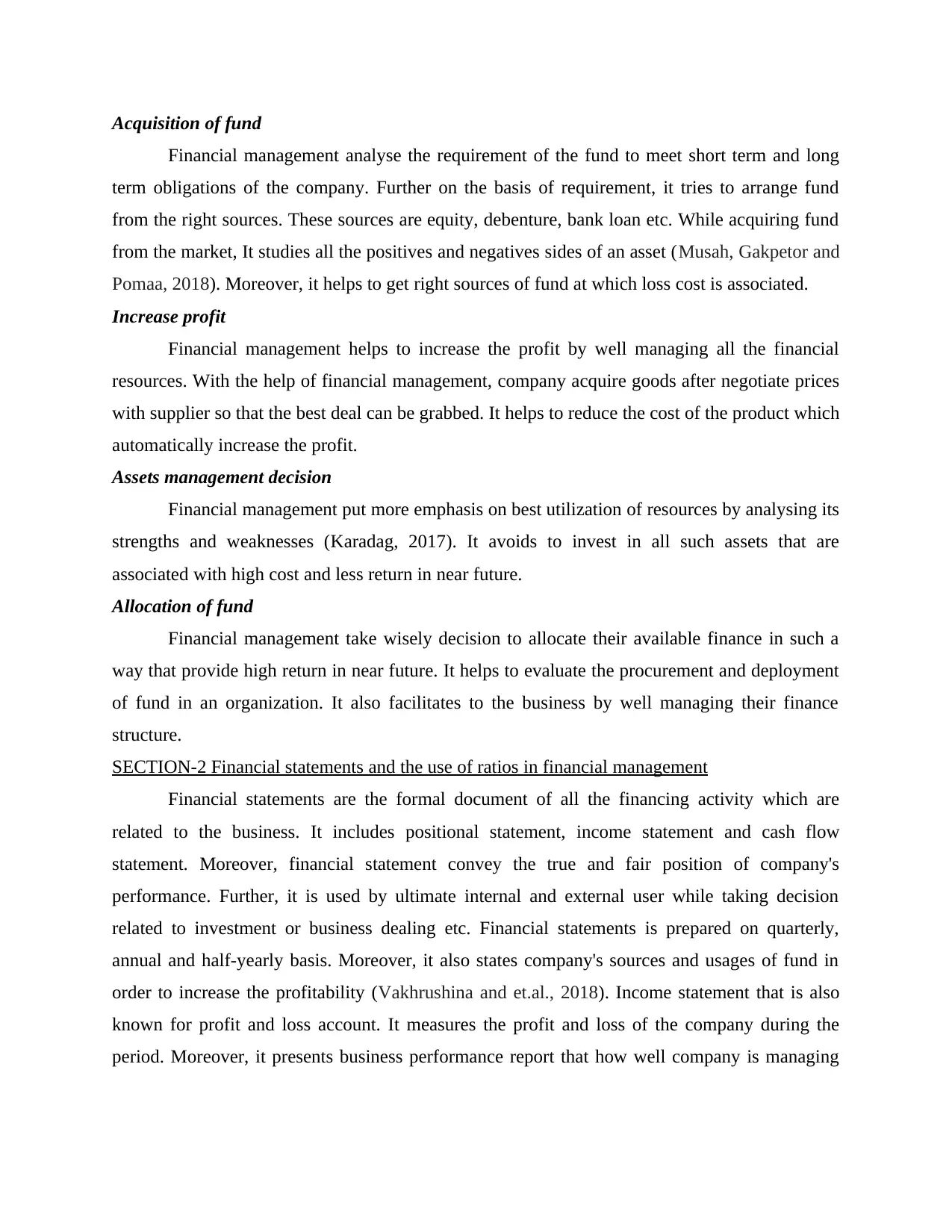
Acquisition of fund
Financial management analyse the requirement of the fund to meet short term and long
term obligations of the company. Further on the basis of requirement, it tries to arrange fund
from the right sources. These sources are equity, debenture, bank loan etc. While acquiring fund
from the market, It studies all the positives and negatives sides of an asset (Musah, Gakpetor and
Pomaa, 2018). Moreover, it helps to get right sources of fund at which loss cost is associated.
Increase profit
Financial management helps to increase the profit by well managing all the financial
resources. With the help of financial management, company acquire goods after negotiate prices
with supplier so that the best deal can be grabbed. It helps to reduce the cost of the product which
automatically increase the profit.
Assets management decision
Financial management put more emphasis on best utilization of resources by analysing its
strengths and weaknesses (Karadag, 2017). It avoids to invest in all such assets that are
associated with high cost and less return in near future.
Allocation of fund
Financial management take wisely decision to allocate their available finance in such a
way that provide high return in near future. It helps to evaluate the procurement and deployment
of fund in an organization. It also facilitates to the business by well managing their finance
structure.
SECTION-2 Financial statements and the use of ratios in financial management
Financial statements are the formal document of all the financing activity which are
related to the business. It includes positional statement, income statement and cash flow
statement. Moreover, financial statement convey the true and fair position of company's
performance. Further, it is used by ultimate internal and external user while taking decision
related to investment or business dealing etc. Financial statements is prepared on quarterly,
annual and half-yearly basis. Moreover, it also states company's sources and usages of fund in
order to increase the profitability (Vakhrushina and et.al., 2018). Income statement that is also
known for profit and loss account. It measures the profit and loss of the company during the
period. Moreover, it presents business performance report that how well company is managing
Financial management analyse the requirement of the fund to meet short term and long
term obligations of the company. Further on the basis of requirement, it tries to arrange fund
from the right sources. These sources are equity, debenture, bank loan etc. While acquiring fund
from the market, It studies all the positives and negatives sides of an asset (Musah, Gakpetor and
Pomaa, 2018). Moreover, it helps to get right sources of fund at which loss cost is associated.
Increase profit
Financial management helps to increase the profit by well managing all the financial
resources. With the help of financial management, company acquire goods after negotiate prices
with supplier so that the best deal can be grabbed. It helps to reduce the cost of the product which
automatically increase the profit.
Assets management decision
Financial management put more emphasis on best utilization of resources by analysing its
strengths and weaknesses (Karadag, 2017). It avoids to invest in all such assets that are
associated with high cost and less return in near future.
Allocation of fund
Financial management take wisely decision to allocate their available finance in such a
way that provide high return in near future. It helps to evaluate the procurement and deployment
of fund in an organization. It also facilitates to the business by well managing their finance
structure.
SECTION-2 Financial statements and the use of ratios in financial management
Financial statements are the formal document of all the financing activity which are
related to the business. It includes positional statement, income statement and cash flow
statement. Moreover, financial statement convey the true and fair position of company's
performance. Further, it is used by ultimate internal and external user while taking decision
related to investment or business dealing etc. Financial statements is prepared on quarterly,
annual and half-yearly basis. Moreover, it also states company's sources and usages of fund in
order to increase the profitability (Vakhrushina and et.al., 2018). Income statement that is also
known for profit and loss account. It measures the profit and loss of the company during the
period. Moreover, it presents business performance report that how well company is managing
Paraphrase This Document
Need a fresh take? Get an instant paraphrase of this document with our AI Paraphraser
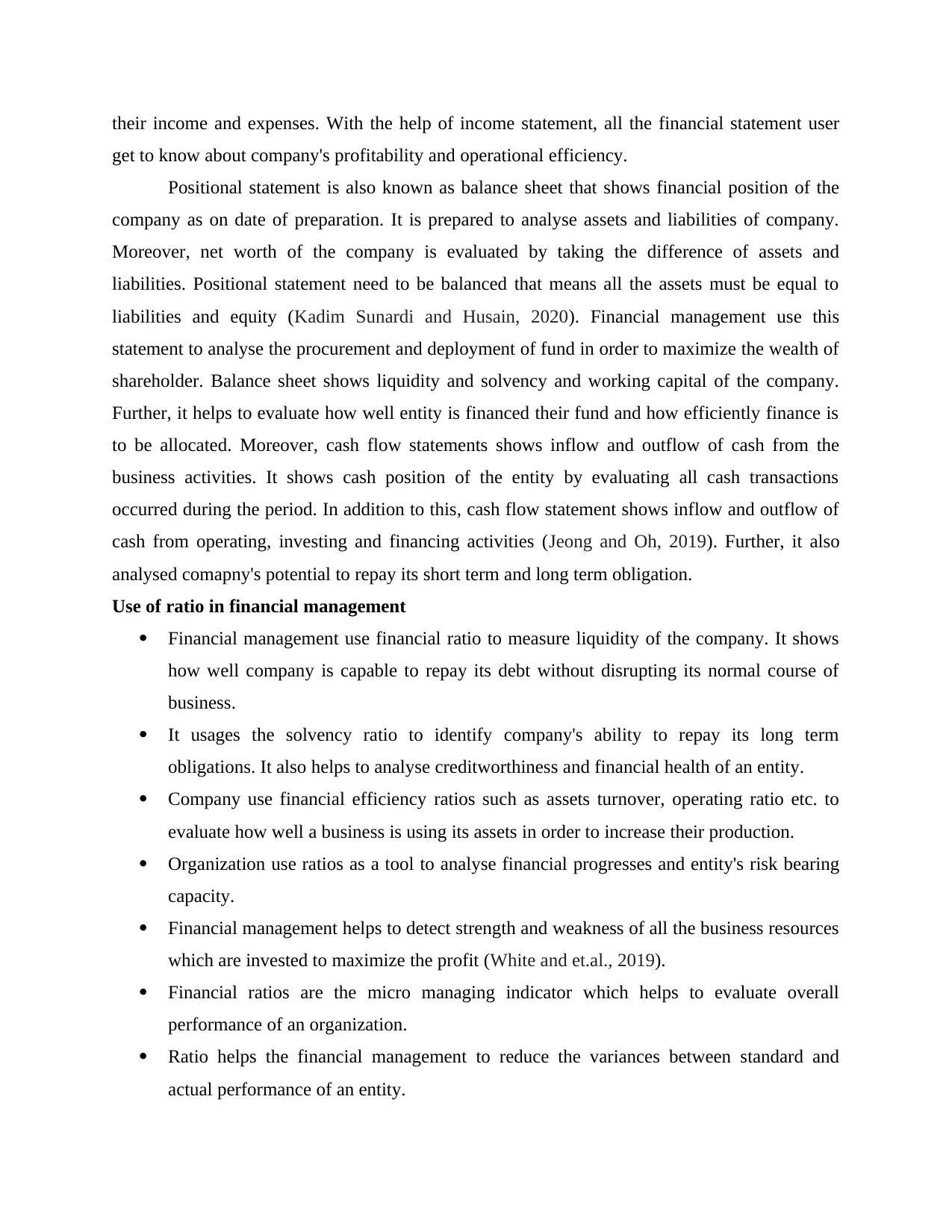
their income and expenses. With the help of income statement, all the financial statement user
get to know about company's profitability and operational efficiency.
Positional statement is also known as balance sheet that shows financial position of the
company as on date of preparation. It is prepared to analyse assets and liabilities of company.
Moreover, net worth of the company is evaluated by taking the difference of assets and
liabilities. Positional statement need to be balanced that means all the assets must be equal to
liabilities and equity (Kadim Sunardi and Husain, 2020). Financial management use this
statement to analyse the procurement and deployment of fund in order to maximize the wealth of
shareholder. Balance sheet shows liquidity and solvency and working capital of the company.
Further, it helps to evaluate how well entity is financed their fund and how efficiently finance is
to be allocated. Moreover, cash flow statements shows inflow and outflow of cash from the
business activities. It shows cash position of the entity by evaluating all cash transactions
occurred during the period. In addition to this, cash flow statement shows inflow and outflow of
cash from operating, investing and financing activities (Jeong and Oh, 2019). Further, it also
analysed comapny's potential to repay its short term and long term obligation.
Use of ratio in financial management
Financial management use financial ratio to measure liquidity of the company. It shows
how well company is capable to repay its debt without disrupting its normal course of
business.
It usages the solvency ratio to identify company's ability to repay its long term
obligations. It also helps to analyse creditworthiness and financial health of an entity.
Company use financial efficiency ratios such as assets turnover, operating ratio etc. to
evaluate how well a business is using its assets in order to increase their production.
Organization use ratios as a tool to analyse financial progresses and entity's risk bearing
capacity.
Financial management helps to detect strength and weakness of all the business resources
which are invested to maximize the profit (White and et.al., 2019).
Financial ratios are the micro managing indicator which helps to evaluate overall
performance of an organization.
Ratio helps the financial management to reduce the variances between standard and
actual performance of an entity.
get to know about company's profitability and operational efficiency.
Positional statement is also known as balance sheet that shows financial position of the
company as on date of preparation. It is prepared to analyse assets and liabilities of company.
Moreover, net worth of the company is evaluated by taking the difference of assets and
liabilities. Positional statement need to be balanced that means all the assets must be equal to
liabilities and equity (Kadim Sunardi and Husain, 2020). Financial management use this
statement to analyse the procurement and deployment of fund in order to maximize the wealth of
shareholder. Balance sheet shows liquidity and solvency and working capital of the company.
Further, it helps to evaluate how well entity is financed their fund and how efficiently finance is
to be allocated. Moreover, cash flow statements shows inflow and outflow of cash from the
business activities. It shows cash position of the entity by evaluating all cash transactions
occurred during the period. In addition to this, cash flow statement shows inflow and outflow of
cash from operating, investing and financing activities (Jeong and Oh, 2019). Further, it also
analysed comapny's potential to repay its short term and long term obligation.
Use of ratio in financial management
Financial management use financial ratio to measure liquidity of the company. It shows
how well company is capable to repay its debt without disrupting its normal course of
business.
It usages the solvency ratio to identify company's ability to repay its long term
obligations. It also helps to analyse creditworthiness and financial health of an entity.
Company use financial efficiency ratios such as assets turnover, operating ratio etc. to
evaluate how well a business is using its assets in order to increase their production.
Organization use ratios as a tool to analyse financial progresses and entity's risk bearing
capacity.
Financial management helps to detect strength and weakness of all the business resources
which are invested to maximize the profit (White and et.al., 2019).
Financial ratios are the micro managing indicator which helps to evaluate overall
performance of an organization.
Ratio helps the financial management to reduce the variances between standard and
actual performance of an entity.
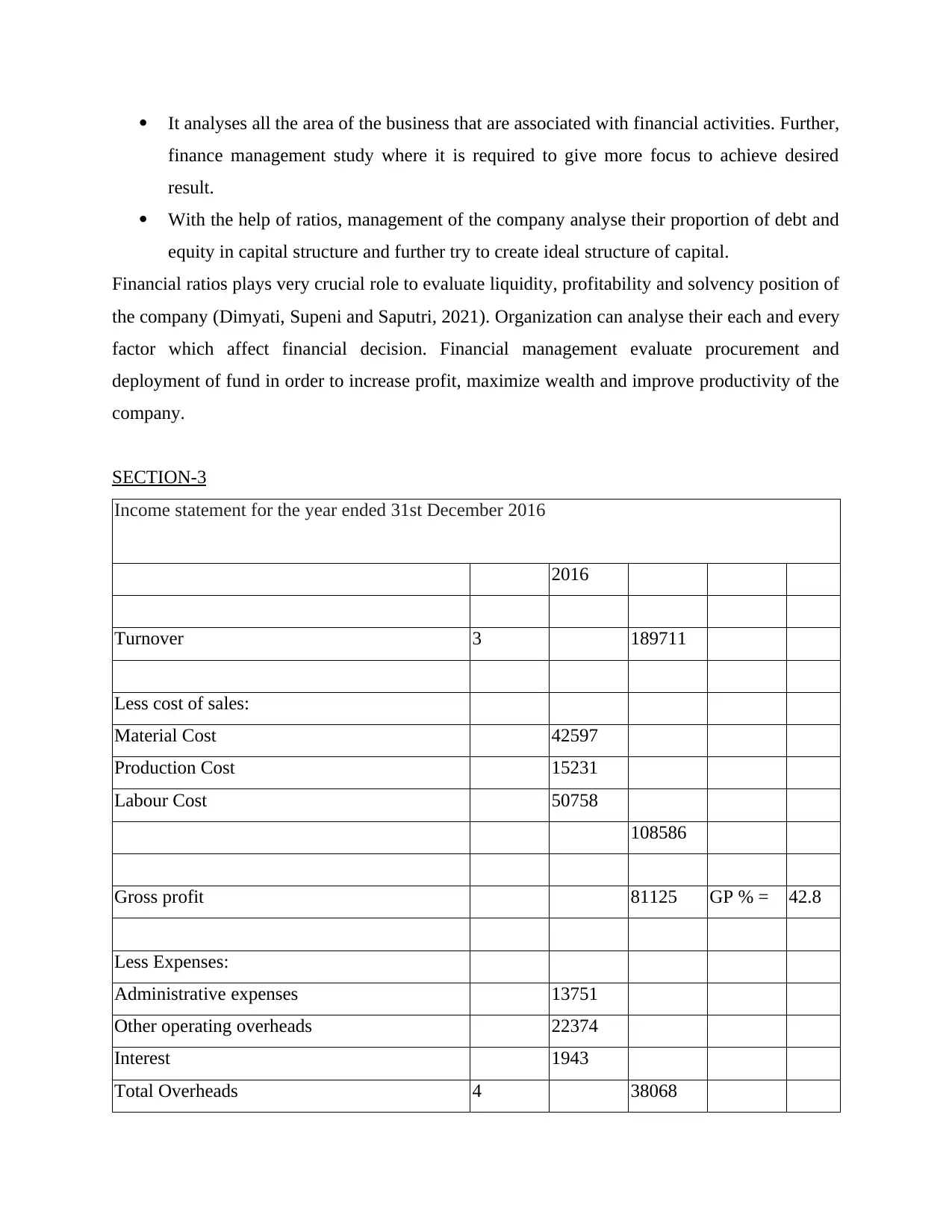
It analyses all the area of the business that are associated with financial activities. Further,
finance management study where it is required to give more focus to achieve desired
result.
With the help of ratios, management of the company analyse their proportion of debt and
equity in capital structure and further try to create ideal structure of capital.
Financial ratios plays very crucial role to evaluate liquidity, profitability and solvency position of
the company (Dimyati, Supeni and Saputri, 2021). Organization can analyse their each and every
factor which affect financial decision. Financial management evaluate procurement and
deployment of fund in order to increase profit, maximize wealth and improve productivity of the
company.
SECTION-3
Income statement for the year ended 31st December 2016
2016
Turnover 3 189711
Less cost of sales:
Material Cost 42597
Production Cost 15231
Labour Cost 50758
108586
Gross profit 81125 GP % = 42.8
Less Expenses:
Administrative expenses 13751
Other operating overheads 22374
Interest 1943
Total Overheads 4 38068
finance management study where it is required to give more focus to achieve desired
result.
With the help of ratios, management of the company analyse their proportion of debt and
equity in capital structure and further try to create ideal structure of capital.
Financial ratios plays very crucial role to evaluate liquidity, profitability and solvency position of
the company (Dimyati, Supeni and Saputri, 2021). Organization can analyse their each and every
factor which affect financial decision. Financial management evaluate procurement and
deployment of fund in order to increase profit, maximize wealth and improve productivity of the
company.
SECTION-3
Income statement for the year ended 31st December 2016
2016
Turnover 3 189711
Less cost of sales:
Material Cost 42597
Production Cost 15231
Labour Cost 50758
108586
Gross profit 81125 GP % = 42.8
Less Expenses:
Administrative expenses 13751
Other operating overheads 22374
Interest 1943
Total Overheads 4 38068
⊘ This is a preview!⊘
Do you want full access?
Subscribe today to unlock all pages.

Trusted by 1+ million students worldwide
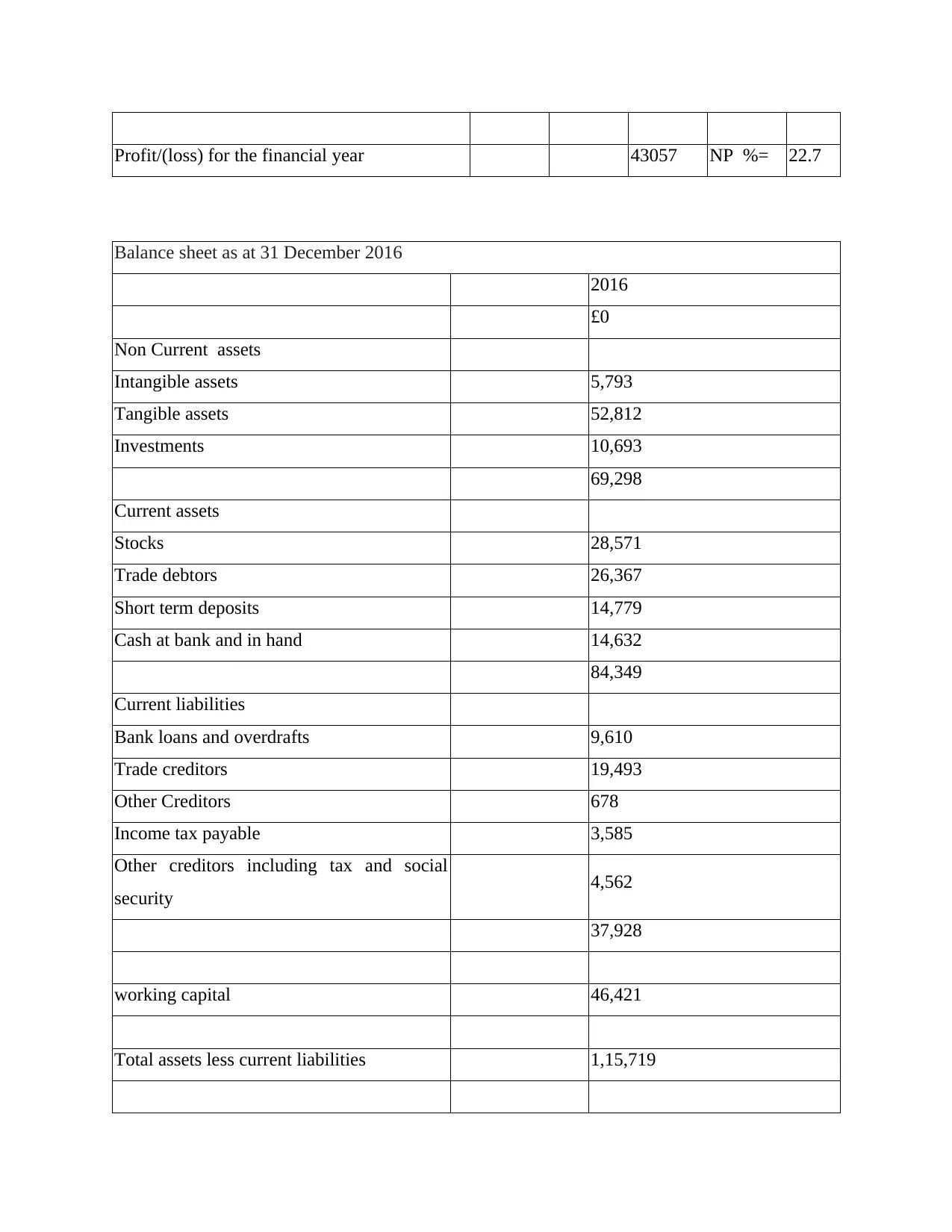
Profit/(loss) for the financial year 43057 NP %= 22.7
Balance sheet as at 31 December 2016
2016
£0
Non Current assets
Intangible assets 5,793
Tangible assets 52,812
Investments 10,693
69,298
Current assets
Stocks 28,571
Trade debtors 26,367
Short term deposits 14,779
Cash at bank and in hand 14,632
84,349
Current liabilities
Bank loans and overdrafts 9,610
Trade creditors 19,493
Other Creditors 678
Income tax payable 3,585
Other creditors including tax and social
security 4,562
37,928
working capital 46,421
Total assets less current liabilities 1,15,719
Balance sheet as at 31 December 2016
2016
£0
Non Current assets
Intangible assets 5,793
Tangible assets 52,812
Investments 10,693
69,298
Current assets
Stocks 28,571
Trade debtors 26,367
Short term deposits 14,779
Cash at bank and in hand 14,632
84,349
Current liabilities
Bank loans and overdrafts 9,610
Trade creditors 19,493
Other Creditors 678
Income tax payable 3,585
Other creditors including tax and social
security 4,562
37,928
working capital 46,421
Total assets less current liabilities 1,15,719
Paraphrase This Document
Need a fresh take? Get an instant paraphrase of this document with our AI Paraphraser
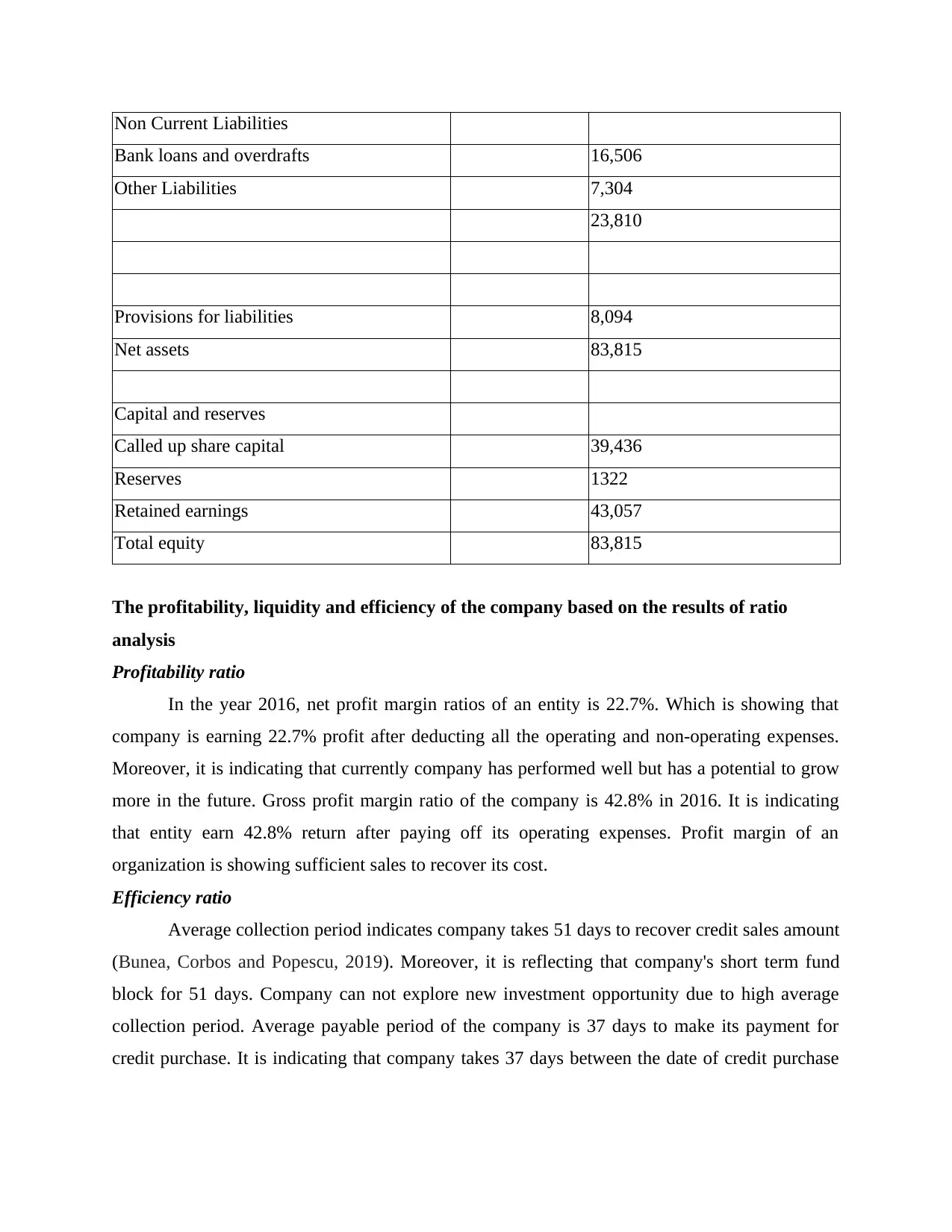
Non Current Liabilities
Bank loans and overdrafts 16,506
Other Liabilities 7,304
23,810
Provisions for liabilities 8,094
Net assets 83,815
Capital and reserves
Called up share capital 39,436
Reserves 1322
Retained earnings 43,057
Total equity 83,815
The profitability, liquidity and efficiency of the company based on the results of ratio
analysis
Profitability ratio
In the year 2016, net profit margin ratios of an entity is 22.7%. Which is showing that
company is earning 22.7% profit after deducting all the operating and non-operating expenses.
Moreover, it is indicating that currently company has performed well but has a potential to grow
more in the future. Gross profit margin ratio of the company is 42.8% in 2016. It is indicating
that entity earn 42.8% return after paying off its operating expenses. Profit margin of an
organization is showing sufficient sales to recover its cost.
Efficiency ratio
Average collection period indicates company takes 51 days to recover credit sales amount
(Bunea, Corbos and Popescu, 2019). Moreover, it is reflecting that company's short term fund
block for 51 days. Company can not explore new investment opportunity due to high average
collection period. Average payable period of the company is 37 days to make its payment for
credit purchase. It is indicating that company takes 37 days between the date of credit purchase
Bank loans and overdrafts 16,506
Other Liabilities 7,304
23,810
Provisions for liabilities 8,094
Net assets 83,815
Capital and reserves
Called up share capital 39,436
Reserves 1322
Retained earnings 43,057
Total equity 83,815
The profitability, liquidity and efficiency of the company based on the results of ratio
analysis
Profitability ratio
In the year 2016, net profit margin ratios of an entity is 22.7%. Which is showing that
company is earning 22.7% profit after deducting all the operating and non-operating expenses.
Moreover, it is indicating that currently company has performed well but has a potential to grow
more in the future. Gross profit margin ratio of the company is 42.8% in 2016. It is indicating
that entity earn 42.8% return after paying off its operating expenses. Profit margin of an
organization is showing sufficient sales to recover its cost.
Efficiency ratio
Average collection period indicates company takes 51 days to recover credit sales amount
(Bunea, Corbos and Popescu, 2019). Moreover, it is reflecting that company's short term fund
block for 51 days. Company can not explore new investment opportunity due to high average
collection period. Average payable period of the company is 37 days to make its payment for
credit purchase. It is indicating that company takes 37 days between the date of credit purchase

and date of making payment. Company earn return with the helps of investing this fund into
short term investment. That's why company has chosen higher average payable period.
Liquidity ratio
In the year 2016, company has 2.22 times current assets than current liabilities.
Moreover, it is reflecting that entity has enough current assets to meet short term current
liabilities (Asandimitra and Kautsar, 2019). Further, current ratio put an impact on working
capital management of an organization. In addition to this, company has maintained ideal current
ratio in order to maintain liquidity. Quick ratio of the company is 1.47 times in 2016. Which is
showing that entity has 1.47 times liquid assets over the liabilities. Moreover, company has ideal
quick ratio that is more than one. It represents an organization has enough cash and cash
equivalent like cash in hand, cash at bank and short term market security to meet its obligations.
SECTION-4 suggestion to improve financial performance
Company can improve their performance by implementing different type of cost saving
techniques. Further, these techniques and methods helps to improve financial
performance of an organization.
Business should adopt all the necessary assets which help to increase productivity.
Management should have knowledge of all the financial information which affect
business decision (Anthony and et.al., 2019).
Financial manager should prepare standard budget in order to evaluate financial
performance of the company.
Purchase department of an entity should negotiate their prices with quotation so that
goods can be purchased at the best price.
Company should keep balanced capital structure which helps to attract more and more
customer, supplier, lender etc.
Marketing segment should prepare some strategy to reduce credit sales and improve
average collection period. These techniques can be discounting, offer, cash discount etc.
Financial management should take wise decision in terms of deployment of fund because
it will help to get higher return.
Company should use idle cash to repay its debt and long term obligations. With the help
of idle cash, company can maximize the wealth of shareholder by paying high dividend
amount (Yang, 2021).
short term investment. That's why company has chosen higher average payable period.
Liquidity ratio
In the year 2016, company has 2.22 times current assets than current liabilities.
Moreover, it is reflecting that entity has enough current assets to meet short term current
liabilities (Asandimitra and Kautsar, 2019). Further, current ratio put an impact on working
capital management of an organization. In addition to this, company has maintained ideal current
ratio in order to maintain liquidity. Quick ratio of the company is 1.47 times in 2016. Which is
showing that entity has 1.47 times liquid assets over the liabilities. Moreover, company has ideal
quick ratio that is more than one. It represents an organization has enough cash and cash
equivalent like cash in hand, cash at bank and short term market security to meet its obligations.
SECTION-4 suggestion to improve financial performance
Company can improve their performance by implementing different type of cost saving
techniques. Further, these techniques and methods helps to improve financial
performance of an organization.
Business should adopt all the necessary assets which help to increase productivity.
Management should have knowledge of all the financial information which affect
business decision (Anthony and et.al., 2019).
Financial manager should prepare standard budget in order to evaluate financial
performance of the company.
Purchase department of an entity should negotiate their prices with quotation so that
goods can be purchased at the best price.
Company should keep balanced capital structure which helps to attract more and more
customer, supplier, lender etc.
Marketing segment should prepare some strategy to reduce credit sales and improve
average collection period. These techniques can be discounting, offer, cash discount etc.
Financial management should take wise decision in terms of deployment of fund because
it will help to get higher return.
Company should use idle cash to repay its debt and long term obligations. With the help
of idle cash, company can maximize the wealth of shareholder by paying high dividend
amount (Yang, 2021).
⊘ This is a preview!⊘
Do you want full access?
Subscribe today to unlock all pages.

Trusted by 1+ million students worldwide
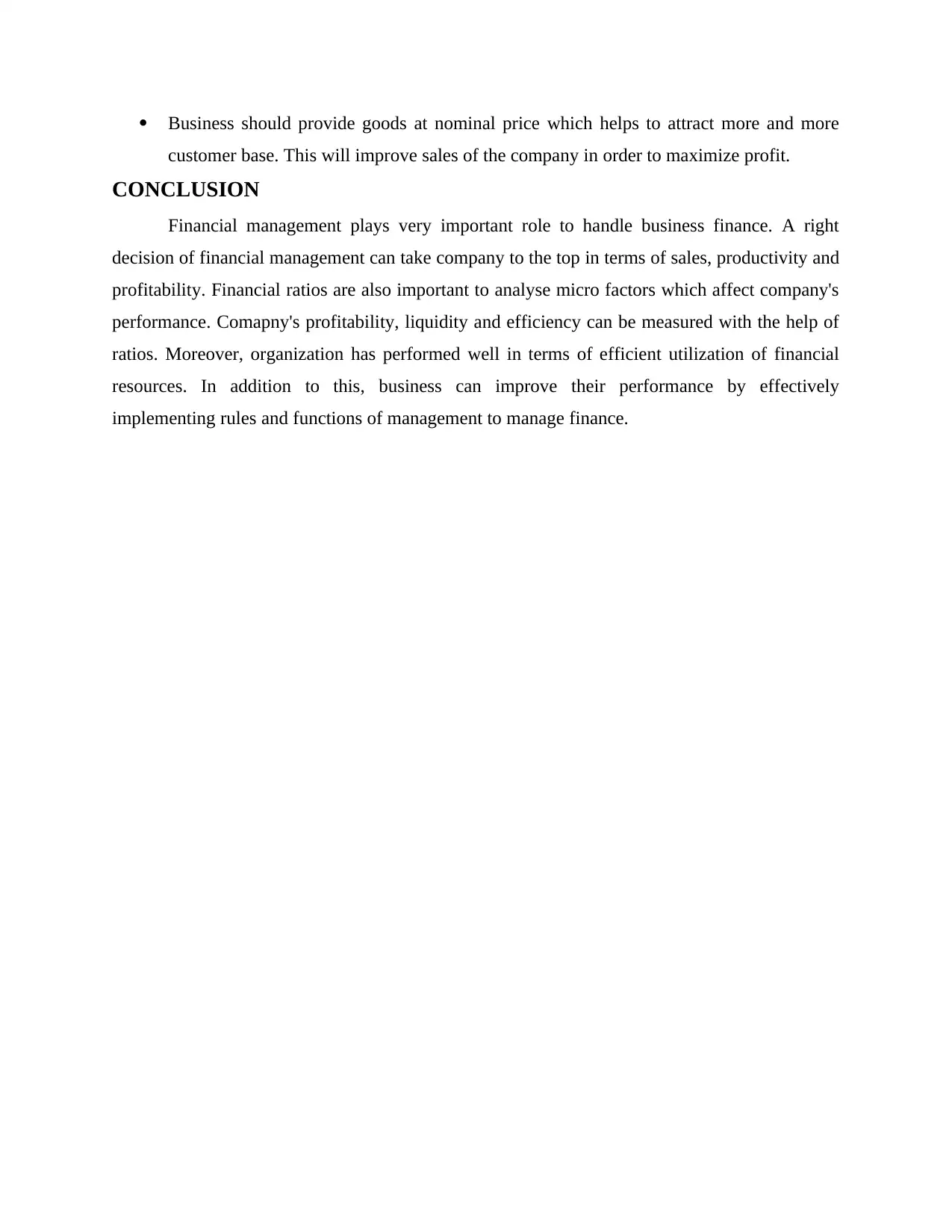
Business should provide goods at nominal price which helps to attract more and more
customer base. This will improve sales of the company in order to maximize profit.
CONCLUSION
Financial management plays very important role to handle business finance. A right
decision of financial management can take company to the top in terms of sales, productivity and
profitability. Financial ratios are also important to analyse micro factors which affect company's
performance. Comapny's profitability, liquidity and efficiency can be measured with the help of
ratios. Moreover, organization has performed well in terms of efficient utilization of financial
resources. In addition to this, business can improve their performance by effectively
implementing rules and functions of management to manage finance.
customer base. This will improve sales of the company in order to maximize profit.
CONCLUSION
Financial management plays very important role to handle business finance. A right
decision of financial management can take company to the top in terms of sales, productivity and
profitability. Financial ratios are also important to analyse micro factors which affect company's
performance. Comapny's profitability, liquidity and efficiency can be measured with the help of
ratios. Moreover, organization has performed well in terms of efficient utilization of financial
resources. In addition to this, business can improve their performance by effectively
implementing rules and functions of management to manage finance.
Paraphrase This Document
Need a fresh take? Get an instant paraphrase of this document with our AI Paraphraser
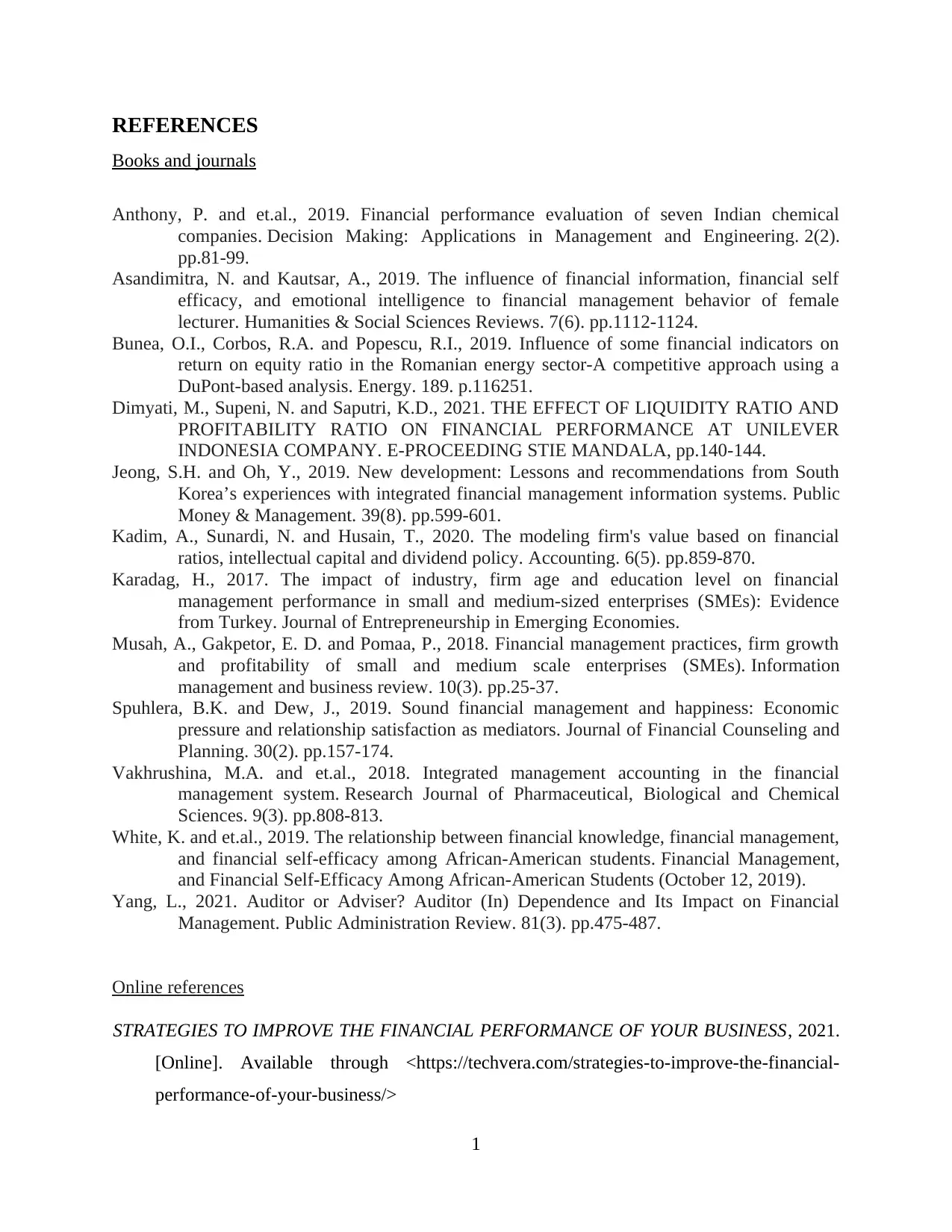
REFERENCES
Books and journals
Anthony, P. and et.al., 2019. Financial performance evaluation of seven Indian chemical
companies. Decision Making: Applications in Management and Engineering. 2(2).
pp.81-99.
Asandimitra, N. and Kautsar, A., 2019. The influence of financial information, financial self
efficacy, and emotional intelligence to financial management behavior of female
lecturer. Humanities & Social Sciences Reviews. 7(6). pp.1112-1124.
Bunea, O.I., Corbos, R.A. and Popescu, R.I., 2019. Influence of some financial indicators on
return on equity ratio in the Romanian energy sector-A competitive approach using a
DuPont-based analysis. Energy. 189. p.116251.
Dimyati, M., Supeni, N. and Saputri, K.D., 2021. THE EFFECT OF LIQUIDITY RATIO AND
PROFITABILITY RATIO ON FINANCIAL PERFORMANCE AT UNILEVER
INDONESIA COMPANY. E-PROCEEDING STIE MANDALA, pp.140-144.
Jeong, S.H. and Oh, Y., 2019. New development: Lessons and recommendations from South
Korea’s experiences with integrated financial management information systems. Public
Money & Management. 39(8). pp.599-601.
Kadim, A., Sunardi, N. and Husain, T., 2020. The modeling firm's value based on financial
ratios, intellectual capital and dividend policy. Accounting. 6(5). pp.859-870.
Karadag, H., 2017. The impact of industry, firm age and education level on financial
management performance in small and medium-sized enterprises (SMEs): Evidence
from Turkey. Journal of Entrepreneurship in Emerging Economies.
Musah, A., Gakpetor, E. D. and Pomaa, P., 2018. Financial management practices, firm growth
and profitability of small and medium scale enterprises (SMEs). Information
management and business review. 10(3). pp.25-37.
Spuhlera, B.K. and Dew, J., 2019. Sound financial management and happiness: Economic
pressure and relationship satisfaction as mediators. Journal of Financial Counseling and
Planning. 30(2). pp.157-174.
Vakhrushina, M.A. and et.al., 2018. Integrated management accounting in the financial
management system. Research Journal of Pharmaceutical, Biological and Chemical
Sciences. 9(3). pp.808-813.
White, K. and et.al., 2019. The relationship between financial knowledge, financial management,
and financial self-efficacy among African-American students. Financial Management,
and Financial Self-Efficacy Among African-American Students (October 12, 2019).
Yang, L., 2021. Auditor or Adviser? Auditor (In) Dependence and Its Impact on Financial
Management. Public Administration Review. 81(3). pp.475-487.
Online references
STRATEGIES TO IMPROVE THE FINANCIAL PERFORMANCE OF YOUR BUSINESS, 2021.
[Online]. Available through <https://techvera.com/strategies-to-improve-the-financial-
performance-of-your-business/>
1
Books and journals
Anthony, P. and et.al., 2019. Financial performance evaluation of seven Indian chemical
companies. Decision Making: Applications in Management and Engineering. 2(2).
pp.81-99.
Asandimitra, N. and Kautsar, A., 2019. The influence of financial information, financial self
efficacy, and emotional intelligence to financial management behavior of female
lecturer. Humanities & Social Sciences Reviews. 7(6). pp.1112-1124.
Bunea, O.I., Corbos, R.A. and Popescu, R.I., 2019. Influence of some financial indicators on
return on equity ratio in the Romanian energy sector-A competitive approach using a
DuPont-based analysis. Energy. 189. p.116251.
Dimyati, M., Supeni, N. and Saputri, K.D., 2021. THE EFFECT OF LIQUIDITY RATIO AND
PROFITABILITY RATIO ON FINANCIAL PERFORMANCE AT UNILEVER
INDONESIA COMPANY. E-PROCEEDING STIE MANDALA, pp.140-144.
Jeong, S.H. and Oh, Y., 2019. New development: Lessons and recommendations from South
Korea’s experiences with integrated financial management information systems. Public
Money & Management. 39(8). pp.599-601.
Kadim, A., Sunardi, N. and Husain, T., 2020. The modeling firm's value based on financial
ratios, intellectual capital and dividend policy. Accounting. 6(5). pp.859-870.
Karadag, H., 2017. The impact of industry, firm age and education level on financial
management performance in small and medium-sized enterprises (SMEs): Evidence
from Turkey. Journal of Entrepreneurship in Emerging Economies.
Musah, A., Gakpetor, E. D. and Pomaa, P., 2018. Financial management practices, firm growth
and profitability of small and medium scale enterprises (SMEs). Information
management and business review. 10(3). pp.25-37.
Spuhlera, B.K. and Dew, J., 2019. Sound financial management and happiness: Economic
pressure and relationship satisfaction as mediators. Journal of Financial Counseling and
Planning. 30(2). pp.157-174.
Vakhrushina, M.A. and et.al., 2018. Integrated management accounting in the financial
management system. Research Journal of Pharmaceutical, Biological and Chemical
Sciences. 9(3). pp.808-813.
White, K. and et.al., 2019. The relationship between financial knowledge, financial management,
and financial self-efficacy among African-American students. Financial Management,
and Financial Self-Efficacy Among African-American Students (October 12, 2019).
Yang, L., 2021. Auditor or Adviser? Auditor (In) Dependence and Its Impact on Financial
Management. Public Administration Review. 81(3). pp.475-487.
Online references
STRATEGIES TO IMPROVE THE FINANCIAL PERFORMANCE OF YOUR BUSINESS, 2021.
[Online]. Available through <https://techvera.com/strategies-to-improve-the-financial-
performance-of-your-business/>
1

2
⊘ This is a preview!⊘
Do you want full access?
Subscribe today to unlock all pages.

Trusted by 1+ million students worldwide
1 out of 12
Related Documents
Your All-in-One AI-Powered Toolkit for Academic Success.
+13062052269
info@desklib.com
Available 24*7 on WhatsApp / Email
![[object Object]](/_next/static/media/star-bottom.7253800d.svg)
Unlock your academic potential
Copyright © 2020–2025 A2Z Services. All Rights Reserved. Developed and managed by ZUCOL.



